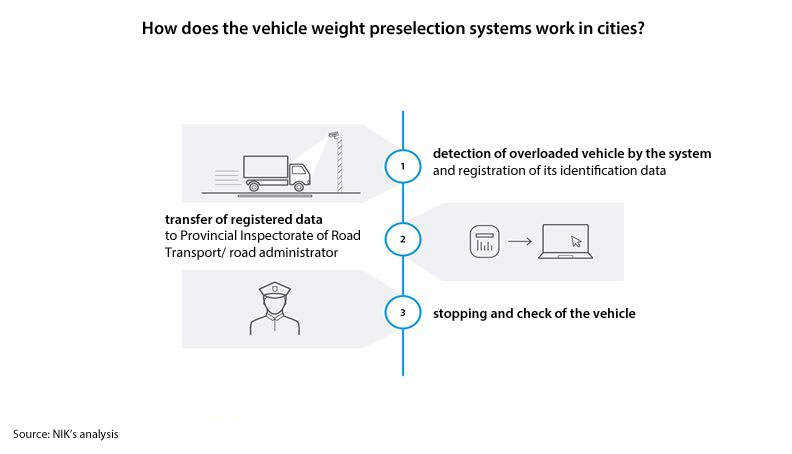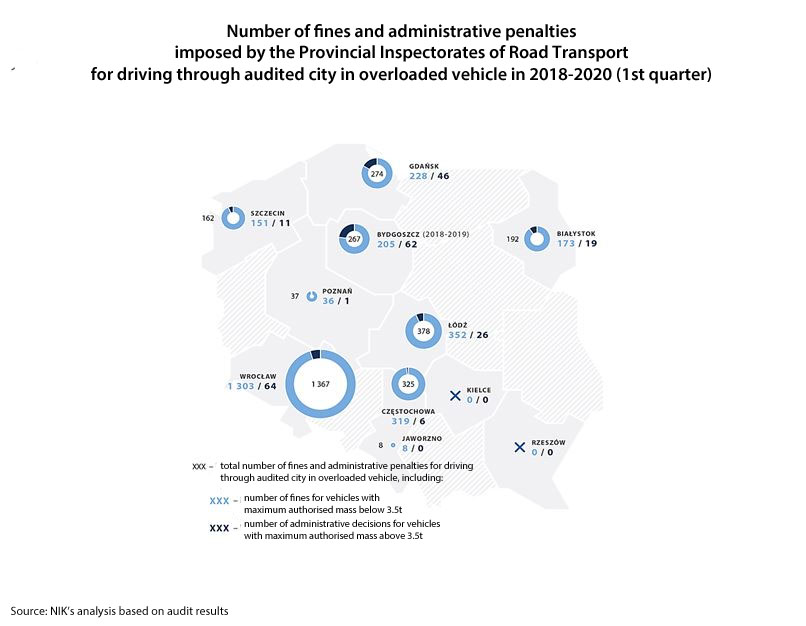NIK about traffic of overloaded vehicles in urban areas
Public administration bodies failed to prevent overloaded vehicles from driving on city roads. Above all, there was no infrastructure to control lorries. The weight preselection systems, although they cost a lot, did not prove very useful in identifying and eliminating overloaded vehicles, as they were not too precise. Also, vehicle weight control points were located quite far from preselection points which gave lorry drivers the opportunity to leave the road without being controlled. Also the Road Transport Inspection (RTI) did not work out any effective solutions to eliminate overloaded vehicles from urban areas. The RTI inspectors conducted only a dozen or so percent of all weight checks within city borders.
The traffic of overloaded vehicles is a huge problem not only for road administrators but also for drivers. In the past years, there has been an increase in the number of cargo transports by car. In 2016, a bit more than 1.5 billion tonnes were transported, whereas in 2019 it was even more than 1.9 billion tonnes. The research done by the Gdańsk University of Technology shows that 14-23 percent of all vehicles on the roads (depending on the road) are overloaded. At the same time, overloaded lorries cause from 35 to 70 percent of damages in the structure of the road surface. The damages give rise to bumps, potholes and ruts on the roads. Also the underground infrastructure is damaged: water and sewage network, electricity network, fibre network and other accompanying facilities. It is worth noting that repairs of a damaged road surface are very work-consuming and expensive.
Overloaded lorries are an issue especially in large cities which are big transport hubs at the same time. They are often located on national or international thoroughfares, near industrial regions, intensely developing logistics and storage centres or sea ports. A solution supporting the selection of overloaded vehicles for a detailed inspection are the weight preselection systems using the Weigh-in-Motion (WIM) technology. They are the measurement systems designed to capture the axle weights and total weights of vehicles without the need to stop them.

In Poland, inspectors from the Provincial Inspectorates of Road Transport (PIRT), while selecting vehicles to control the axle load and total weight, may use indications of the vehicle weight preselection systems. These systems are supposed to support the vehicle control system, and also the system of penalising drivers for exceeding acceptable vehicle weights and axle loads. The Polish law does not provide for the Weigh-in-Motion preselection devices. The norms to be met by these systems have not been defined, either.
How does the European preselection system work?
In Germany, the Federal Office of Freight Transport (BAG) uses the vehicle weight preselection devices e.g. for semi-automatic protection of bridges and flyovers before the entry of overloaded vehicles. In case a vehicle which is too heavy and has excessive axle load is approaching the bridge, special sensors automatically activate the barrier which prevents the vehicle from entering the bridge. The vehicle is then directed to a car park nearby, where it is weighed by BAG Officers on certified measurement devices.
In Great Britain, the signal about an overloaded vehicle passing a preselection point is sent automatically to all police patrols nearby. The information transferred to the police cars includes the data making it easy to identify the vehicle, such as its licence number, make or colour. After the Police has located the car, it is then brought to the control point where officers from the Driver and Vehicle Standards Agency (DVSA) control the total weight and the axle load of the vehicle.
Key audit findings
In terms of personnel management, organisation and equipment, both the road administrators and the Provincial Inspectorates of Road Transport were prepared to perform their tasks related to the elimination of overloaded vehicles. Adequate infrastructure for weight checks was missing, though. In two cities there was not a single vehicle weight control point. In others the number of such points ranged from one to nine.
In five cities the PIRT inspectors did not use all vehicle weight control points they had at their disposal. In case of building new roads, only in two cities such points were included in road construction plans.
According to NIK, the weight preselection systems did not have much impact on eliminating overloaded vehicles. Their construction absorbed a lot of money, though (in six audited cities it was over PLN 22.5 million). The access to data from the vehicle weight preselection system was provided to the PIRT inspectors in five out of 11 audited cities. Though, the inspectors sporadically used the system indications to select vehicles for weight checks. Besides, in many cases the system did not operate properly: it wrongly indicated vehicle overload, there were breaks in data access or the system failed to recognise vehicles’ number plates. Also some errors in the data registration occurred. In two cities the road administrator was not aware of the problems with the preselection system operation.
The preselection systems can be used in the weight check process only when the distance and the location of the measurement point (preselection gateways) makes it possible to stop the vehicle indicated by the system and bring it to the control point. Expansion of the preselection systems without building the vehicle weight control points in their vicinity does not really help raise effectiveness of the vehicle weight checks. The NIK audit showed that in five audited cities, vehicles – after passing the preselection point – could bypass the nearest weight control point at the junction or by bypass routes. In several cases the distance between the preselection point and the weight control point was huge, e.g. in Szczecin it reached 42 km. Also in Szczecin, from 2018 to 2020 (1st quarter) out of the total number of 68.2 million vehicles registered by the weight preselection system, in over 183 thousand cases the axle load exceeded the acceptable 11.5 tonnes, of which over 154.5 thousand vehicles exceeded the acceptable weight of 40 tonnes). In that period in Szczecin, only 655 weight checks were conducted (0.36 percent and 0.42 percent respectively of the total number of checks registered by the preselection system).
Besides, in two cities the PIRT inspectors did not have access to data from the vehicle weight preselection system, although it was mounted in the city. It showed that cooperation between the Provincial Inspectorate of Road Transport and the road administrator was far from perfect. One city (Rzeszów) had the weight preselection system in place but the inspectors did not use it because there were no control points in that city. The data from the vehicle weight preselection system in Rzeszów showed that in September 2018 and 2019 and in January 2020, nearly 6 million vehicles in total drove through the measurement points, of which nearly 51.5 thousand were overloaded. Those vehicles could not be controlled, though.
NIK auditors established that the Road Transport Inspection did not work out any solutions to eliminate overloaded vehicles from the audited cities. The Framework Control Plans developed by the Chief Inspector of Road Transport for 2018-2020, specified the number of weight checks to be carried out in individual provinces, ignoring the need to conduct at least partial checks within the city borders. Conducting weight checks in urban areas is more difficult and requires e.g. involving more inspectors. It results from the type of the land development: dense road network, numerous junctions enabling drivers to bypass the control point or heavy traffic. This, in turn, requires the use of an additional vehicle to bring the preselected lorry to the control point. Therefore, most Road Transport Inspections, to achieve the required results, chose a more simple organisational solution and carried out the vehicle checks outside big city centres. The vehicle weight checks were very rare in the cities (Gdańsk is an exception).

In 2018-2020 (1st half), the Provincial Inspectorates of Road Transport conducted the total of nearly 52 thousand vehicle weight checks nationwide, half of which dealt with vehicles of more than 3.5 tonnes. Over 3.2 thousand administrative penalties totalling nearly PLN 18 million were imposed on such vehicles. At the same time, as a result of weight checks of vehicles up to 3.5 tonnes fines of over PLN 6 million were levied.
According to NIK, only in three cities the road administrators and the Provincial Inspectorates of Road Transport cooperated smoothly to protect the cities against overloaded vehicles. As a consequence, the PIRT inspectors used static scales constructed by the road administrators for dynamic weighing of lorries. Also, that cooperation helped provide sufficient infrastructure for weight checks and also ensured collaboration between the road administrators’ employees and PIRT inspectors in terms of weight checks.
In all eleven cities covered by the audit, strategic documents defining assumptions of the cities’ development were adopted. They provided for gradual elimination of transit traffic of lorries from built-up areas, by redirecting it to bypass systems, by building roads to transfer lorries from city centres and residential areas, as well as by increasing the roads’ carrying capacity.
Investments conducted in cities helped limit the impact of overloaded vehicles on the road infrastructure. In all the audited cities, administrative solutions were implemented to reduce the traffic of lorries in selected city parts or in their entire area. They consisted in limiting the traffic of lorries of the specified maximum authorised mass all over in the city, local speed limits and accessibility of streets for vehicles with the specified maximum authorised mass, designating transit roads for lorries and also introducing tonnage limitations for transit through the city area.
The Chief Inspectorate of Road Transport appointed a team with the aim of implementing the system of controlling and penalising identified offences related to the traffic of oversize vehicles using the Weigh-in-Motion devices. Although the team was appointed over three years ago, the concepts of legal, metrological and technical solutions have not been implemented ever since. According to the Minister of Infrastructure, this is a complex and long-lasting process, requiring a research project and cooperation between the Chief Inspectorate of Road Transport, the General Directorate for National Roads and Motorways and the Central Office of Measures. NIK has pointed out, though, that pursuant to Article 10d of the Directive (EU) 2015/719 of the European Parliament and of the Council of 29 April 2015, Member States should, by 27 May 2021, take specific measures to identify vehicles or vehicle combinations in circulation that are likely to have exceeded the relevant weight limits and that should therefore be checked. In the opinion of the Minister of Infrastructure, the existing system of preselection devices complies with the provisions of the said Article. However, the NIK audit revealed that this system is not very effective in urban areas.
Recommendations
To the Minister of Transport to:
- introduce standards where road administrators are obliged to seek the opinion of the relevant Provincial Inspectorate of Road Transport concerning the location of vehicle control points in the process of planning road investments.
To the Chief Inspector of Road Transport to:
- indicate – as part of vehicle check plans prepared by the Chief Inspector of Road Transport – the share of weight checks that need to be carried out in cities with district rights;
- intensify works to implement an automatic WIM system and to penalise offences identified in that way.
To road administrators to:
- take efforts to make sure the existing preselection systems are more useful and help the PIRT inspectors in selecting vehicles that need to be checked;
make reviews in the presence of PIRT representatives of the vehicle control points in view of making weight checks there as well as examine their usefulness for potential checks using the existing and planned preselection vehicle weight points.


